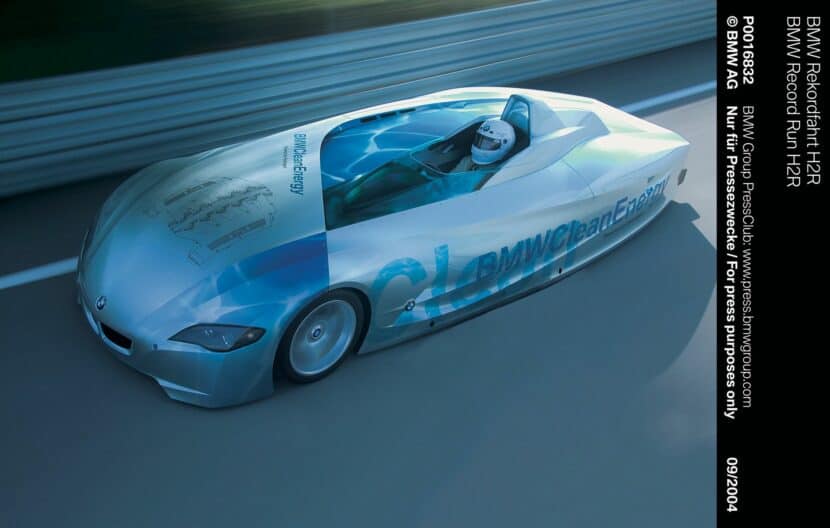BMW recently introduced the iX5 Hydrogen, marking their entry into the production series of fuel cell vehicles. The company plans to offer this innovative vehicle to selected customers across the globe. But many of us also remember another hydrogen-powered BMW: the BMW H2R. In 2004, BMW unveiled the futuristic concept aimed to demonstrate the potential of hydrogen as a fuel source for high-performance vehicles. Of course, it never made it past the prototype stage, but it set the tone for future hydrogen-powered BMWs. Let’s dive into the details of what the BMW H2R brought to the table.
Powertrain and Hydrogen Fuel System
The H2R was originally designed to run on gasoline, but BMW decided to switch to hydrogen in order to demonstrate its potential. At the heart of the BMW H2R lies a modified 6.0-liter V12 engine, specifically engineered to run on hydrogen fuel. The very same engine was used in the BMW 760i. One of the engine modifications includes adapting a fuel injection system capable of handling hydrogen, featuring integrated injection valves within the intake manifolds. The engine produces 232 horsepower and 285 lb-ft of torque, and it can propel the BMW H2R to a top speed of 187.62 mph (302.4 km/h).
Performance and Aerodynamics
The BMW H2R is a very lightweight car, weighing in at just 1,560 kilograms (3,437 lbs). This is due to its carbon fiber bodywork and aluminum frame. The car’s aerodynamics are also very efficient, with a drag coefficient of just 0.21. Therefore, the BMW H2R showcased great performance capabilities for the times. It sprints from 0 to 100 km/h (0 to 62 mph) in a mere 6.1 seconds. The car’s sleek and aerodynamic design plays a vital role in achieving such impressive performance. With its low-slung body, streamlined cockpit, and an adjustable rear wing, the H2R minimizes drag and enhances stability at high speeds.
Safety Features and Record Attempts
The BMW H2R incorporates several features to protect the driver. The CFRP safety cell, surrounding the driver, provides robust protection in the event of an accident. The liquid hydrogen is stored in a cryogenic tank within a carbon fiber-reinforced plastic (CFRP) safety cell. The tank maintains the hydrogen at a frigid -253 degrees Celsius, ensuring it remains in a liquid state. To accommodate the distinct combustion characteristics of a hydrogen-powered vehicle, specific adjustments were made, including the implementation of specialized valves. Furthermore, an air-cooling process was developed for each cylinder to prevent premature ignition of the subsequent hydrogen/air mixture during combustion. This precaution was necessary due to the elevated temperature resulting from hydrogen combustion.
The BMW H2R was built to set world records, and it did not disappoint. In September 2004, the car set nine world records at the Miramas proving ground in France. These records included the fastest flying kilometer and mile, along with the quickest standing-start mile and kilometer. Furthermore, the H2R showed the world that hydrogen-powered cars could be fast and efficient and it certainly inspired BMW to continue developing hydrogen-powered cars.
H2R records:
- Flying-start kilometer: 11.99 sec 187.62 mph
- Flying-start mile: 19.91 sec 181.85 mph
- Standing-start 1/8 kilometer: 9.92 sec 45.62 mph
- Standing-start ¼ kilometer: 14.93 sec 60.62 mph
- Standing-start ½ mile: 17.27 sec 65.15 mph
- Standing-start mile: 36.73 sec 98.60 mph
- Standing-start 10 miles: 221.05 sec 163.81 mph
- Standing-start kilometer: 26.56 sec 84.72 mph
- Standing-start 10 kilometers: 146.41 sec 153.90 mph
Here are some additional facts about the BMW H2R:
- The car was engineered under the direction of Dr. Raymond Freymann. From 2003 to 2011 he was acting as CEO of BMW Group Research and Technology.
- It took 10 months to develop the H2R.
- The car has a range of about 200 miles (322 km).
- The fuel tank can be filled in about 3 minutes.
[Photos: BMW]




